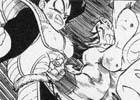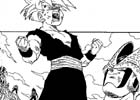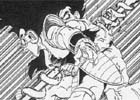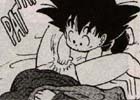Dragon Ball
| Also Known as: DB, Dragon Ball Z (Vols. 17-42), DBZ (Vols. 17-42) | ||
| Genre: Action/Comedy | ||
| Length: 42 Volumes | ||
| Allegiance: Shueisha/ Viz Communications | ||
| Mangaka: Toriyama Akira | ||
| Vintage: 1985 – 1995 | ||
| Intelligence Agency Report by: Kuzu Ryu Sen | ||
| There is a legend that says if all seven Dragon Balls are gathered, the dragon Shenlong can be summoned to grant any wish. Bulma, a young teenage girl who has just recently learned of the story, is so intrigued that she actually begins her own quest to find the Dragon Balls. While searching she runs into (almost quite literally) a strange boy with superhuman strength, a wooden staff, and – most surprisingly – a tail. His name is Son Goku, and to Bulma’s shock and elation, he possesses the 4-Star Dragon Ball. However, Goku is unwilling to give up a precious heirloom from his grandfather, so Bulma suggests that the pair journey together to find the rest of the Dragon Balls. No one could have ever imagined what this fateful meeting would produce… | ||
|
|
||
| Research Agent Report by: Kuzu Ryu Sen | ||
| Plot Characters Impact Visual |
7.25 8.75 8.25 7.75 |
|
| Overall | 7.75 | |
| (not an average) | ||
| There are probably not too many people left on either side of the Pacific that still don’t know about Dragon Ball to some capacity. The popularity of Toriyama Akira’s creation has swept across Asia and is responsible in large part for anime’s explosion in North America. Mind you, Dragon Ball is hardly a literary masterpiece, but it does know exactly how to maintain a grip on the reader.
Given “Drag-on Ball’s” reputation, it was difficult to maintain an unbiased state of mind at the outset. However, the adventures of Goku and company turned out to be highly refreshing. The pacing was good; the characters were charming, witty, and/or memorable (albeit rather one dimensional); and the combat still maintained some form of elegance, where strategy and positioning ruled above sheer power. More importantly, the plot, while linear, was still rather fresh. Villains ranged from bumbling trios to armies to demons, and each fight had a unique feel to it. This managed to last until approximately volume 21. While the plot became non-linear and somewhat more interesting, the action scenes slowly began to degenerate into “my fireball is bigger than yours.” Furthermore, Toriyama seemed to lose control of the plot. As villain strength spiraled out of control, the number of viable characters who could fight dwindled, and a number of memorable people who brought joy and anger in the first half of the manga were tragically reduced to the role of cheering gallery (there’s just something wrong when Piccolo is the comic relief). While the new characters were good, they just filled the roles vacated by the relegated. By the final saga, it felt that Toriyama had just simply run out of fresh material (and he himself perhaps realized this – look at volume 35’s cover). Just like the story, the art gradually wears down as the series progresses although that is hardly a fault of Toriyama’s artistic skill. Simply put, the choreography and nature of the fights forced the art to be cluttered and confusing. The art of the earlier volumes more accurately represents Toriyama’s skill, with crisp lines and very clear, vivid facial detail. The art is nothing overly special or awe-inspiring, but Toriyama’s simplicity is a valuable asset to Dragon Ball. Overall, the positives of Dragon Ball’s first half outweigh the mediocrities of the second, although it’s a shame to think of the untapped potential that possessed. With all of the humour and action of the television adaptation but none of the filler and delays, Dragon Ball is definitely worth the read.
|
||




